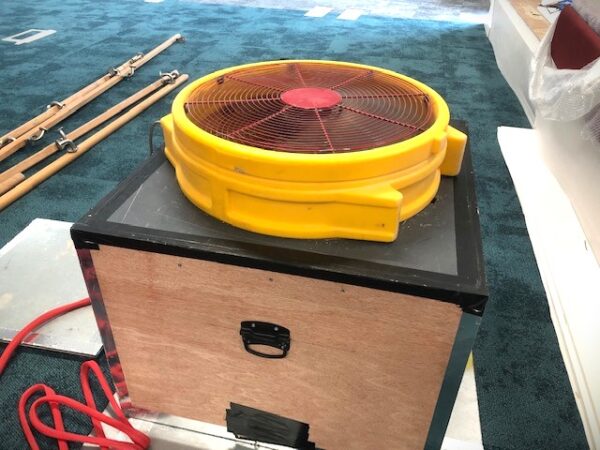Clients often ask the question ‘how do we build our raised floor plenum to pass an air test?’. There are some very important items to consider when designing and constructing a raised floor plenum to pass the air test to BG65/2016. In offices, carpet tiles are usually laid over the raised access floor, if joints between carpet tiles are not lined up with the joints between the raised access panel’s floor tiles or panels, the air leakage will be reduced, particularly if the carpet tiles are glued in place. However, laying of carpet tiles should not be relied on to achieve the target for the raised access floor itself as these can de-bond over time.
Watch out for electrical and data services through the floor plenum
Many raised access floors include electrical and data boxes. The air leakage of these boxes should be ascertained, to ensure that they will not significantly contribute to the raised access floor leakage, and reduce the air floor to the grills or diffusers. Where there are decorative or functional connections through the raised access floor, for example cabling to display boards, suitable method of air sealing these penetrations should be designed.
Ensure wall and floor junctions are sealed within the floor plenums
The perimeter of the floor plenum where the access floor meets the wall is often an area of increased air leakage. To minimise this leakage it may be beneficial to fix a length of metal angle along the perimeter of the floor. Lengths of closed cell board or neoprene strips will increase the quality of the seal between the raised floors and the wall and should prevent excess air leakage.
The walls of floor plenums are most the most vulnerable to air leakage as they are dependent on the type and quality of construction. Plasterboard can be used as the air tightness barrier; however, care should be taken to ensure all joints should be sealed where boards abut other boards, walls, floors and the underside of the raised access floor. This is the same for coated mineral fire boards used in conjunction with fire mastic, the boards should be specified with an air leakage rate of 0.15 l/(s.m2)@50Pa with a life expectancy of at least 25 years.
While poured in-situ concrete floors don’t have any significant air leakage, hollow-core and solid composite precast planks need to be sealed along the plank joints and carefully sealed around service penetrations. Beam and block floors need to be covered by a screed to prevent excess air leakage.

The main air leakage paths within floor plenums
In our experience the main air leakage paths discovered in floor plenums are:
- Gaps at the wall/floor junction
- Gaps at the wall/floor tile junction
- Service penetrations through the access floor, walls and subfloor including cable bundles and cable trays and Pipes
- Poorly installed fire/plenum barriers
- Unsealed cable trunking – must be internally sealed within the void
- Masonry work – incomplete or poorly jointed walls will result in greater air leakage
- Risers need to be properly sealed for plenums/ducting
- Plasterboard on studs at board edges and the ends below the raised floor level
- Gaps between compartment barriers, top of raised access floor and sub floor
- Unsealed columns that pass into the floor void
APT can help you pass your floor plenum test first time
We have experience in help clients pass the their raised floor plenum test to BG65/2016. We can visit site and advise on the best way to construction your raised floor plenum and test it the end of the project to attain compliance and sign off. If you would like more information on our raised floor plenum testing service, please contact Darren on 07775623464 or email us at info@aptsoundtesting.co.uk

